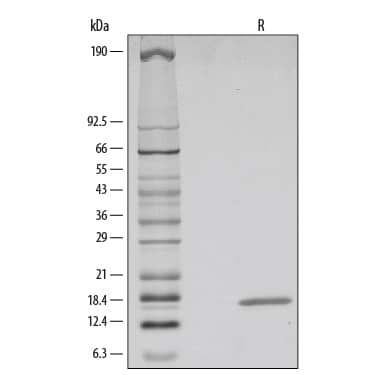Recombinant Human FGF-4 Protein Best Seller
R&D Systems, part of Bio-Techne | Catalog # 235-F4

Key Product Details
Product Specifications
Source
Ser54-Leu206
Purity
Endotoxin Level
N-terminal Sequence Analysis
Predicted Molecular Mass
SDS-PAGE
Activity
The ED50 for this effect is 0.25-1.25 ng/mL.
Reviewed Applications
Read 2 reviews rated 5 using 235-F4 in the following applications:
Scientific Data Images for Recombinant Human FGF-4 Protein
Recombinant Human FGF-4 Protein Bioactivity
Recombinant Human FGF-4 (Catalog # 235-F4) stimulates cell proliferation of the NR6R‑3T3 mouse fibroblast cell line. The ED50 for this effect is 0.25-1.25 ng/mL.Recombinant Human FGF-4 Protein SDS-PAGE
1 μg/lane of Recombinant Human FGF-4 was resolved with SDS-PAGE under reducing (R) conditions and visualized by silver staining, showing a single band at 16 kDa.Formulation, Preparation and Storage
Carrier Free
What does CF mean?CF stands for Carrier Free (CF). We typically add Bovine Serum Albumin (BSA) as a carrier protein to our recombinant proteins. Adding a carrier protein enhances protein stability, increases shelf-life, and allows the recombinant protein to be stored at a more dilute concentration. The carrier free version does not contain BSA.
What formulation is right for me?In general, we advise purchasing the recombinant protein with BSA for use in cell or tissue culture, or as an ELISA standard. In contrast, the carrier free protein is recommended for applications, in which the presence of BSA could interfere.
Carrier: 235-F4
| Formulation | Lyophilized from a 0.2 μm filtered solution in PBS with BSA as a carrier protein. |
| Reconstitution | Reconstitute at 100 μg/mL in sterile PBS containing at least 0.1% human or bovine serum albumin. |
| Shipping | The product is shipped at ambient temperature. Upon receipt, store it immediately at the temperature recommended below. |
| Stability & Storage | Use a manual defrost freezer and avoid repeated freeze-thaw cycles.
|
Carrier Free: 235-F4/CF
| Formulation | Lyophilized from a 0.2 μm filtered solution in PBS. |
| Reconstitution | Reconstitute at 100 μg/mL in sterile PBS. |
| Shipping | The product is shipped at ambient temperature. Upon receipt, store it immediately at the temperature recommended below. |
| Stability & Storage | Use a manual defrost freezer and avoid repeated freeze-thaw cycles.
|
Background: FGF-4
FGF-4 (fibroblast growth factor-4), also known as FGF-K or K-FGF (Kaposi’s sarcoma-associated FGF), is a 25 kDa secreted, heparin-binding member of the FGF family (1, 2). The human FGF-4 cDNA encodes 206 amino acids (aa) with a 33 aa signal sequence and a 173 aa mature protein with an FGF homology domain that contains a heparin binding region near the C-terminus (2). Mature human FGF-4 (aa 71-206) shares 91%, 82%, 94% and 91% aa identity with mouse, rat, canine and bovine FGF-4, respectively. Human FGF-4 has been shown to exhibit cross species activity. Expression of FGF-4 and its receptors, FGF R1c, 2c, 3c and 4, is spatially and temporally regulated during embryonic development (1, 3). Its expression in the mouse trophoblast inner cell mass promotes expression of FGF R2, and is required for maintenance of the trophectoderm and primitive endoderm (3-5). Later in mouse development, FGF-4 works together with FGF-8 to mediate the activities of the apical ectodermal ridge, which direct the outgrowth and patterning of vertebrate limbs (3, 6-9). FGF-4 is proposed to play a physiologically relevant role in human embryonic stem cell self-renewal. It promotes stem cell proliferation, but may also aid differentiation depending on context and concentration, and is often included in embryonic stem cell media in vitro (10-12). A C-terminally truncated 15 kDa isoform that opposes full-length FGF-4 and promotes differentiation is endogenously expressed in human embryonic stem cells. FGF-4 is mitogenic for fibroblasts and endothelial cells in vitro and has autocrine transforming potential (13). It is a potent angiogenesis promoter in vivo and has been investigated as therapy for coronary artery disease (14).
References
- Reuss, B. and O. von Bohlen und Halbach (2003) Cell Tiss. Res. 313:139.
- Hebert, J.M. et al. (1990) Dev. Biol. 138:454.
- Niswander, L. and G.R. Martin (1992) Development 114:755.
- Feldman, B. et al. (1995) Science 267:246.
- Goldin, S.N. and V.E. Papaioannou (2003) Genesis 36:40.
- Sun, X. et al. (2002) Nature 418:501.
- Boulet, A.M. et al. (2004) Dev. Biol. 273:361.
- Yu, K and D.M. Ornitz (2008) Development 135:483.
- Mariani, F.V. et al. (2008) Nature 453:401.
- Johannesson, M. et al. (2009) PLoS ONE 4:e4794.
- Kunath, T. et al. (2007) Development 134:2895.
- Mayshar, Y. et al. (2008) Stem Cells 26:767.
- Hajitou, A. et al. (1998) Oncogene 17:2059.
- Flynn, A. and T. O’Brien (2008) IDrugs 11:283.
Long Name
Alternate Names
Gene Symbol
UniProt
Additional FGF-4 Products
Product Documents for Recombinant Human FGF-4 Protein
Product Specific Notices for Recombinant Human FGF-4 Protein
For research use only

